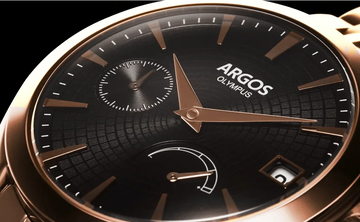Automatic Watches
The Science of Oil in Watch Movements
By Argos Watches
A mechanical watch is a marvel of miniaturization. Behind the smooth sweep of the hands lies a complex network of hundreds of tiny components working together. For this intricate system to function perfectly, every gear, pivot, and spring must operate with minimal resistance. This is where lubrication comes in. It is the unsung hero of watchmaking, and understanding its role is key to appreciating your timepiece.
Friction: The Silent Enemy
Inside a mechanical watch, components like gears and escapements are constantly in motion, generating friction. While a watchmaker's skill can reduce this, friction can never be fully eliminated. If left unchecked, it can lead to serious problems:
- Heat Generation: Friction creates heat, which can damage delicate parts and cause lubricants to break down faster.
- Wear and Tear: Over time, continuous rubbing erodes the surfaces of tiny parts. This can cause increased play in the movement and eventual failure.
- Energy Loss: Friction saps power from the mainspring, making the watch less efficient and impacting its ability to keep accurate time.
The Evolution of Watch Lubricants
Early watchmakers used natural oils from animals or plants, but these had major drawbacks. They would thicken in the cold, thin out in the heat, and degrade over time, attracting dust and turning into a sticky residue.
The revolution came with the invention of synthetic oils. These modern lubricants are engineered to be stable across a wide range of temperatures and to resist breakdown. Today, watchmakers use a variety of specialized oils and greases. A fine, low viscosity oil might be used for the fast-moving escapement, while a thicker grease is applied to high-stress areas like the winding stem and barrel.
The revolution came with the invention of synthetic oils. These modern lubricants are engineered to be stable across a wide range of temperatures and to resist breakdown. Today, watchmakers use a variety of specialized oils and greases. A fine, low viscosity oil might be used for the fast-moving escapement, while a thicker grease is applied to high-stress areas like the winding stem and barrel.
The Challenge of Indian Humidity
Swiss watch oils are engineered for stability, but our climate throws unique challenges. In high humidity, oils can mix with moisture, turning sticky. Sticky oil doesn’t just lose effectiveness: it attracts dust, and dust acts like sandpaper inside your movement.
Extreme heat has its own issues. Oils can thin out, migrate, or even evaporate faster, leaving critical areas dry. On the flip side, colder conditions (say, air-conditioned storage) can make oils thicken and slow the movement.
That’s why synthetic oils are standard today; they’re more resistant to oxidation, less likely to gum up in humidity, and hold up better across India’s temperature swings.
Extreme heat has its own issues. Oils can thin out, migrate, or even evaporate faster, leaving critical areas dry. On the flip side, colder conditions (say, air-conditioned storage) can make oils thicken and slow the movement.
That’s why synthetic oils are standard today; they’re more resistant to oxidation, less likely to gum up in humidity, and hold up better across India’s temperature swings.
Signs of Dried or Degraded Oil
A watch is a machine that gives you subtle clues when something is wrong. Knowing what to look for can help you prevent major damage.
- Inconsistent Timekeeping: The most obvious sign is a watch that is running inconsistently. If it starts losing or gaining more time than usual, it could be a sign of increased friction in the movement.
- Difficulty Winding: If the crown feels stiff or resistant when you wind the watch, it may indicate that the grease on the winding mechanism has dried out.
- Unusual Sounds: While a watch should have a rhythmic beat, grinding, rattling, or an unusually loud ticking noise can signal that components are rubbing against each other without the buffer of a proper lubricant.
The Watchmaker's Role
Lubricating a watch is a precise art that should never be attempted at home. A professional watchmaker follows a meticulous process:
- Disassembly: The watch is completely taken apart, and all components are carefully inspected.
- Cleaning: Every single part is cleaned in a special ultrasonic bath to remove all traces of old oil, dust, and contaminants.
- Application: Using incredibly fine tools, the watchmaker applies tiny, measured amounts of fresh lubricant to each required point, ensuring a precise and perfect coating.
- Reassembly and Testing: The watch is put back together, regulated for accuracy, and tested to ensure it meets its performance standards.
Conclusion
A watch is more than just a tool for telling time; it is a lasting piece of engineering and art. The life and accuracy of a mechanical watch depend on a simple principle: smooth operation through proper lubrication. By understanding the science behind this essential process and getting your watch serviced regularly by a professional, you can ensure it remains a reliable companion for generations to come.
Ready for a Watch That Lasts?

Explore the Argos collection today and discover a timepiece designed for years of reliable wear.



